Quiz 3 - History of Art and Design
1/38
There's no tags or description
Looks like no tags are added yet.
Name | Mastery | Learn | Test | Matching | Spaced |
|---|
No study sessions yet.
39 Terms

What were the differences between early Christianity t. Peter's to a Roman basilica
Architectural changes & additions
Comparisons between Roman and Christian basilicas:
Altar and apse: in Christian churches they were located in the Eastern end of the buildings. This was symbolic. Crucifixions occurred with the crucified facing west - so upon entry into the church worshippers would have Christ facing them. Churches were planned and built to allow for this direction.
In Roman basilicas, apses housed a statue of the emperor. In Christian, it symbolized Christ as judge.
Transepts: these were added to Christian churches and formed a cross-arm at right angles to the nave. This style of basilica is referred to as a cruciform.
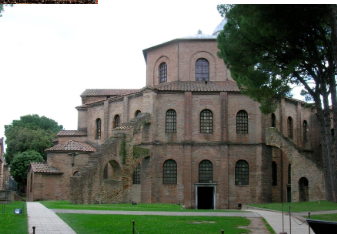
What is it an example of?
Architectural elements?
Style?
San Vitale - Ravenna
San Vitale is an example of a centrally planned church, meaning in the round or as a polygonal building.
Byzantine
These churches radiated out from a central point and were surmounted with a dome.
Emperor Justinian reconfigured the basilica to allow for a sizable congregation. He wanted to restore the grandeur of the Roman Empirethe interior is elaborately decorated with mosaic murals depicting himself and his wife Theodora as devout and pious, yet as resplendent rulers of the kingdom
Octagon with a cupula supported on a tall drum
Buttresses to support the walls.
The exterior of the church is brick and the form of the building is broken up with windows and buttresses (exterior support structures that take the weight off of buildings allowing for more windows).
Inside are highly decorative gold mosaics and marble- this floods the interior with a golden light.
The central dome ceiling mural was added centuries later
Note: Birds = early Christianity artwork
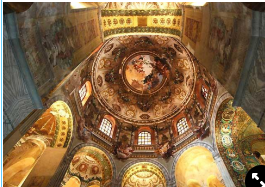
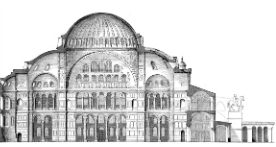
What is it?
Architectural elements?
Byzantium
Hagia Sophia: ‘Holy Wisdom’
Style: Byzantine
Constantinople: (Istanbul, Turkey)
Pendentives: architectural breakthrough
A square basilica
Hagia Sophia is dedicated to Christ: Hagia (Holy) and Sophia (Wisdom).
The success of the Hagia Sophia’s architecture lies in its combining elements of the basilica with enormous rising vaults.
Because of the size of the main dome, buttresses were still used as support outside of the building. The central dome rises to 55’ above the floor- the largest vaulted space in ancient or medieval times.
Justinian I was facing revolt within his empire, so to help suppress it, he commissioned what was an Imperial church of worship: the emperor, his court and clergy.
The minarets (towers) were added in 1453 when the building became a mosque. Originally, there would have been Christian mosaics which have been covered over with Islamic imagery.
Commissioned by Justinian. Two Greek mathematicians were hired to plan Hagia Sophia.
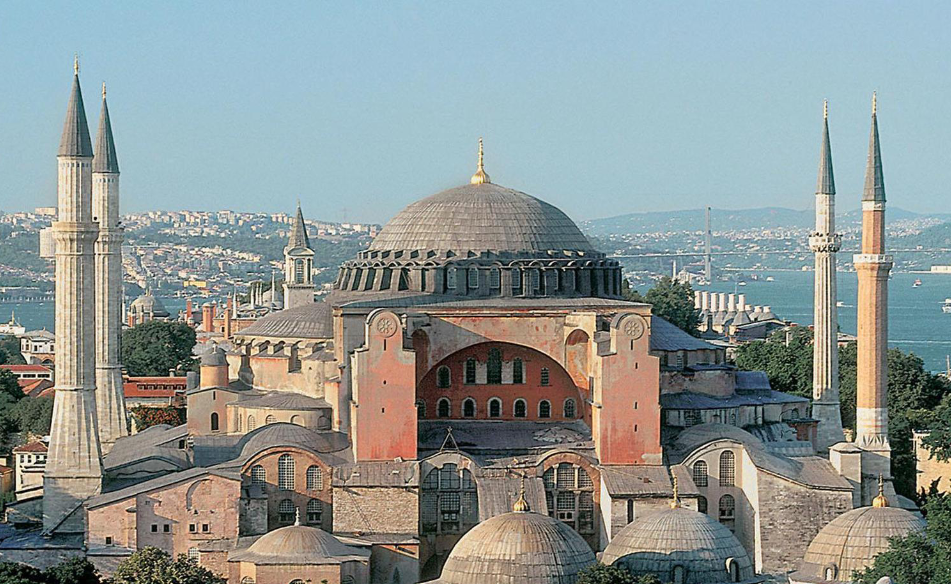
What are the meanings/symbolism of the following Early Christianity symbols:
doves
chi rho
trees/columns
shepard
lamb
Doves: Holy Spirit. In Christian art, the dove was often shown with a halo or rays of light shining down on it to represent holiness and divinity.
Chi rho: A Christian symbol formed from the first two letters X and P of the Greek word for Christ. It serves as a potent reminder of his life, teachings, and his sacrifice for humanity.
Trees/columns: Cross
Dove: Holy Spirit
Shepard: Christ as the Good Shepherd
Lamb: Lamb of God
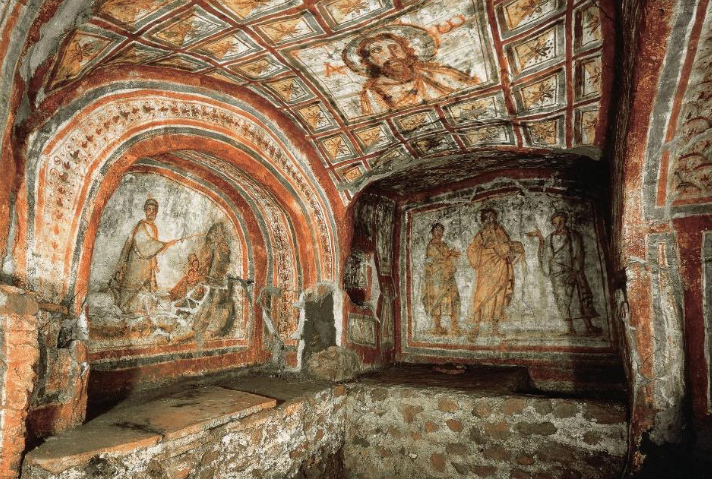
What are Roman catacombs?
The earliest Christian imagery can be found in Roman catacombs. In the catacombs, Christians could meet secretively, give funerary rites, or hide from persecution.
These catacombs were a series of passageways and small burial chambers that ran underneath the city of Rome.
The horizontal shelves for burial are referred to as loculi
Wealthier people would have larger areas that would accommodate a sarcophagus - ancient coffins
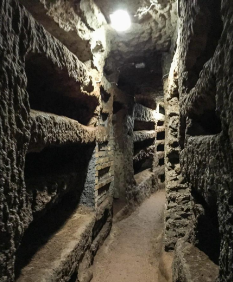
What is the Sarcophagi? Meaning & use? What imagery was seen on them?
Christians believed in resurrection and salvation and this meant they didn’t cremate bodies: people were buried in simple shrouds or if they were wealthy in Sarcophagi: ancient coffins
Scenes of Christs life decorated these
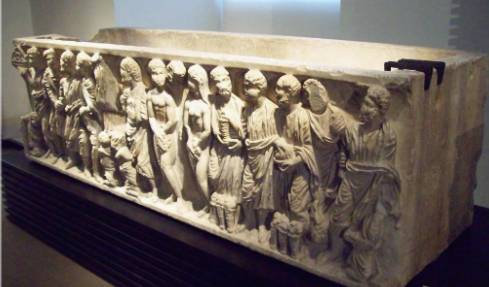
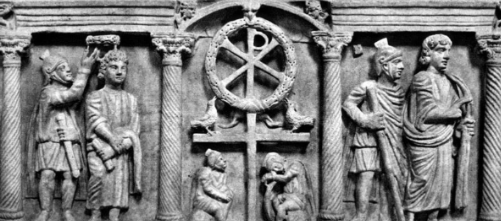
What is this? Style of art? Meaning? Use?
Low relief carving taken from a sarcophagus showing Christ prior to crucifixion.
Early Christian Art
The Greek symbol for Christ is on top of a cross. At the base are two Roman soldiers (who guarded the cross). The figure to the left is receiving a crown of thorns (Christ), the figure to the right is being escorted by a Roman soldier. This sarcophagus belonged to a Christian
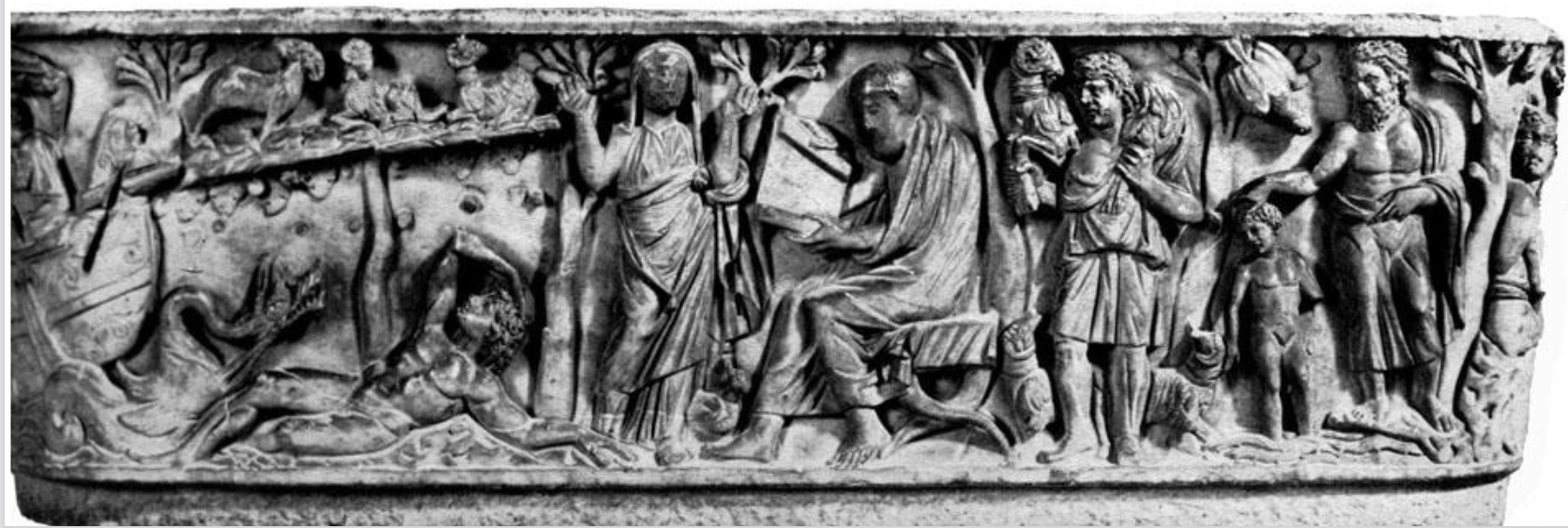
What is this and what was it used for? Style? Where is it? What do the figures and symbols mean (left to right)?
Early Christian Sarcophagus:
4 th century A.D.
Rome
Marble
Wealthy Romans would’ve been buried in a sarcophagus, wealthy Christians carried forward this tradition.
Low relief sculpture depicting a pairing between the old and new testament. This was very common in Early Christian Art.
The figures are Greek/Roman in appearance: classical dress & togas, Jonah’s body is a Classical depiction (ancient).
From left to right: Jonah is emerging from the mouth of the whale (referencing the old testament).
Beside him is a muse raising her hands towards heaven in mourning. She’s an early reference to Mary or the Madonna: mother of god. Behind her are trees: the cross. A robed figure is reading scriptures beside her. Next to him is a man holding a sheep: the Good Shepard (Christ). On the far left is St. John the Baptist baptizing a child: symbolizing rebirth and salvation (baptism) = The person buried here will be ascending to the Kingdom of Heaven.
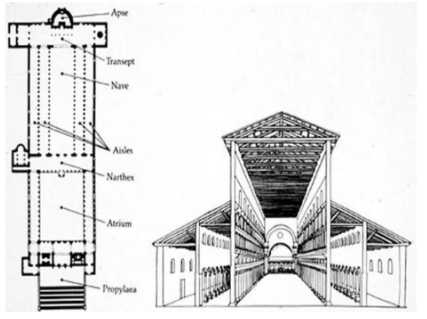
What is this? Style?
Old St. Peter’s basilica
Rome
Early Christianity
Earliest example of a Christian ‘church’
Brick exterior, mosaic, frescos and marble interior
Introduction of transept (cross-arm): known as cruciform architecture.
Churches placed on site with apse facing west.
At the end, the altar and apse are framed with a Roman arch of triumph. This is referencing Christianity’s triumph of Christ over the Roman Emperor.
Entry was from the front rather than the side. The nave height was extended, the colonnades were kept
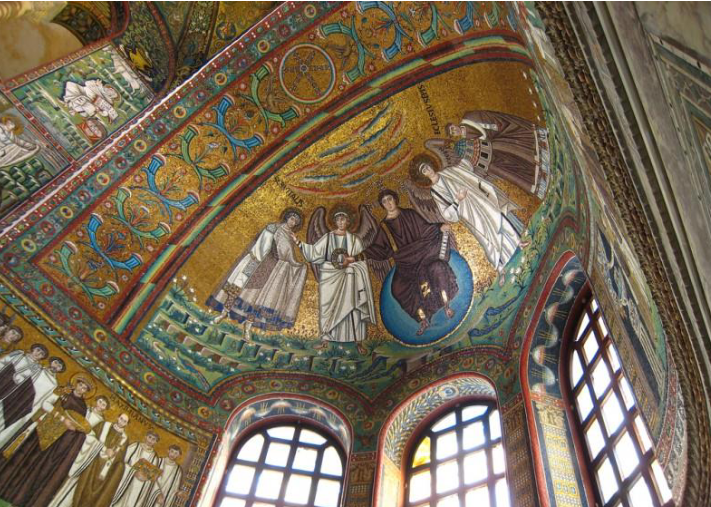
What is this? Style? Note design aspects about it
Apse mosaic: Christ with San Vitale
Byzantine
Christ is seated on the globe (sign of royalty). What do you notice about his facial appearance compared to contemporary depictions of Christ?
He is beardless = young
His halo has the Christian cross and he’s flanked by two angels. He’s handing a jeweled crown to San Vitale, a Roman slave and Christian martyr. To the far right, a bishop is holding a model of the church.
Note: the depiction and drapery of the figures is conceptual, not naturalistic. The folds of cloth sit flat, the bodies aren’t moving naturally and are frontal. There’s a lack of perspective and Christ appears to be floating above the globe: an absence of shadow. This interpretation is more stylistic.
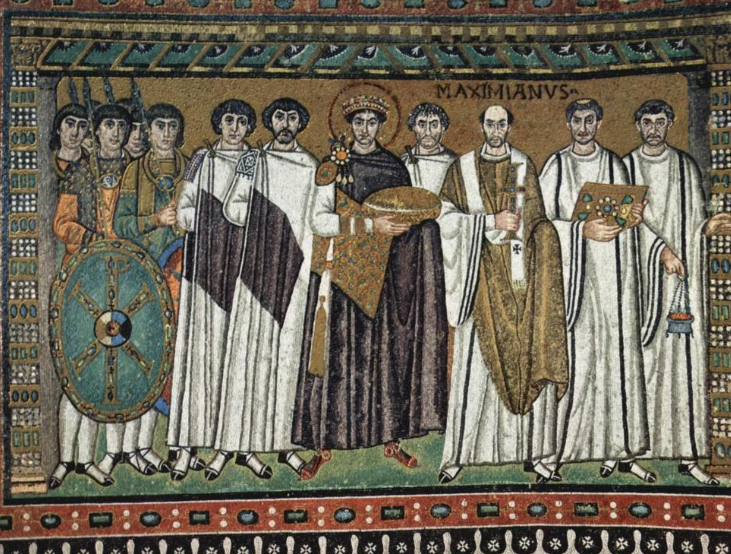
What is this? Note design aspects about it
Apse mosaic: Court of Justinian
Byzantine
Justinian is seen clothed in the same purple robe as Christ. He also has a halo. To his right, the Archbishop wears a gold robe and holds a jeweled cross- he’s identified by the Maximianvs above his head. Beside him are three members of the clergy. In behind stand the court officials and military guard.
Note: the green shield bares the Christian cross ‘chi-rho’.
This mural shows Justinian’s ability to rule as head of the church and state. He’s a worthy successor of Constantine

What is this?
Apse mosaic: Court of Theodora
Byzantine
Theodora was Justinian’s wife and in this mosaic she’s shown with her court ladies on the right, two clergymen on the left. She’s also wearing a purple robe and her head is framed by a halo. She’s offering a golden chalice to the clergymen, and on the bottom of her gown is a scene showing the three kings offering gifts (often referred to as the magi).
This mural is on the left of Christ which is a less dominant position compared to Christ’s right (‘right hand of God’ where Justinian is). There is also hierarchy in her placement within the picture frame, she’s placed further back into the frame, indicating less power than her husband.
Note: vertical, frontal position of figures and diagonal placement of feet and lack of shadow. Movement is created in the mosaics through colour and pattern.
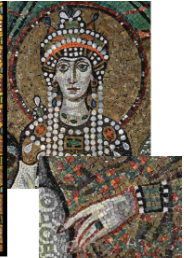
What are the San Vitale mosaics? Style? What do they mean
San Vitale mosaics: Italy
Byzantium: 547 A.D.
Approximately 8’ x 12’ wide each
Mosaics with gold: three scenes
Justinian never visited the city of Ravenna, so the implementation of these murals was key to show his ability to rule.
The gold and halos, reference to Christ and clergy, and inclusion of court officials shows he (and Theodora) had earthly and spiritual connections.
The gold background connects them to the spirit world.
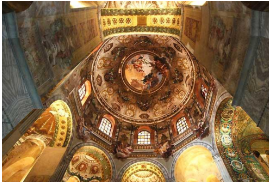
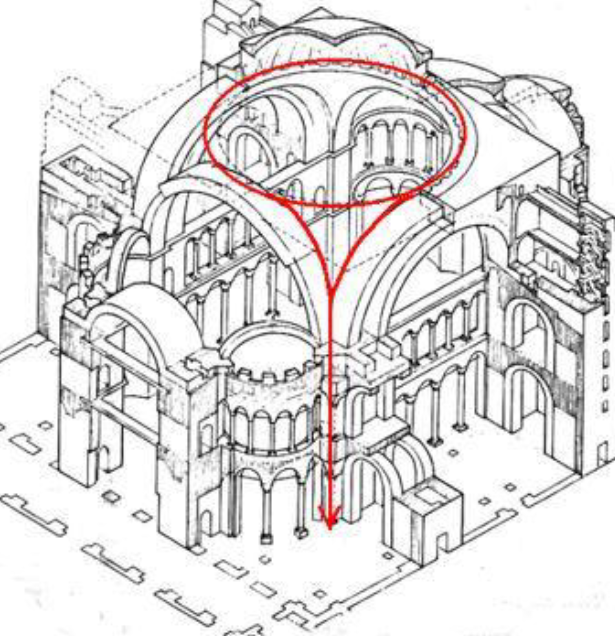
What is this showing?
Pendentives
These are called pendentives (from the Latin ‘to hang’): triangular segments with concave sides
These pendentives were hidden by columns and not visible to the eye.
The pendentives provided a transition from a square or polygonal plan to the round base of the dome. This allowed for a transition of lighter and larger domes.
This was a significant architectural breakthrough.

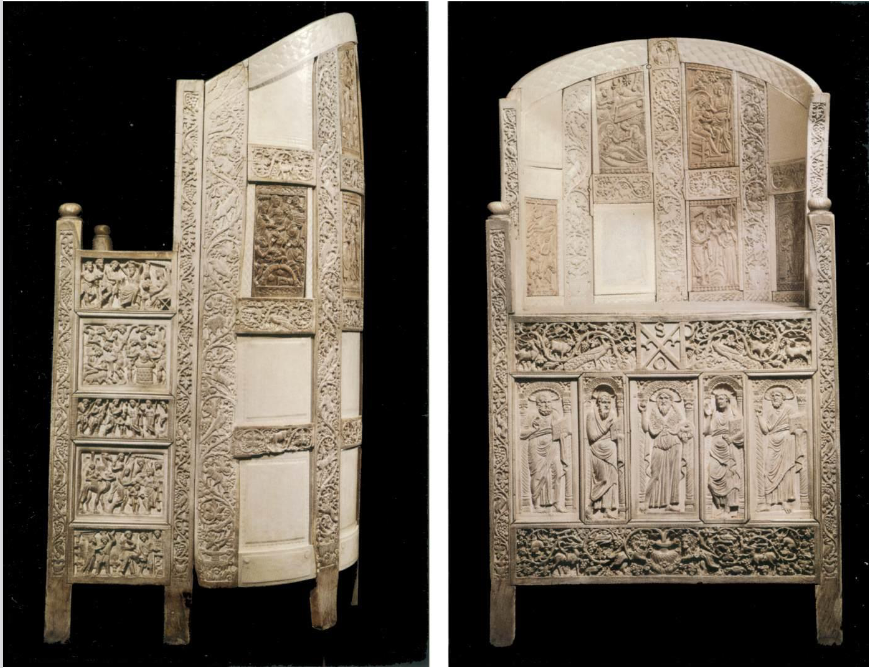
What is this? Style? List design elements?
Throne of Maximian
Carved ivory in relief: links Ravenna, Italy to Alexandria, Egypt.
Style: mix of Early Christian and Byzantine art
Made for Archbishop Maximianus.
Front: the Four Evangelists around John the Baptist, who is holding a medallion with the Lamb of God and Maximianus's name above him.
Back: 24 panels depicting the Life of Christ and scenes from the Life of the Virgin (Mary).
Sides: 10 panels from the Story of Joseph in the Book of Genesis.
The form is derived from a Roman barrel chair. The round back indicates it wasn’t meant to be against a wall, but placed in the round.
There’s no headrest and the straight upright back indicates he would have sat erect with hands placed on the arms: this is not a lounging chair for relaxing, but one used to receive audiences. Formal.
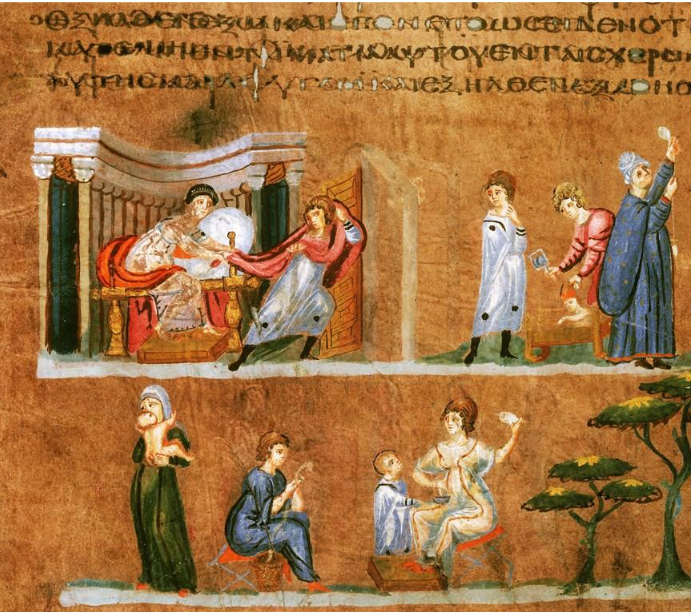
What is this?
‘Joseph and Potiphar’s Wife: Vienna Genesis
Illuminated manuscript
Codex
Purple sheets which indicates an imperial owner- it has been attributed to Justinian I. Gold and silver script characteristic of Byzantine work. Illustrated scenes from the bibleoriginally 96 pages long: 24 survive. Each page shows a continuous narrative that flows throughout the book.
Note: may have been an influence from Trajan’s Column.
What is the Codex?
The Codex:
Previously, text and images had been recorded on papyrus scrolls that unrolled for the reader. They could reach 30-33 feet in length.
The codex was pages of flat sheets of parchment and vellum (calfskin) bound together and covered like our modern day books.
This meant they were easier to preserve which allowed for better colour illustrations and text.
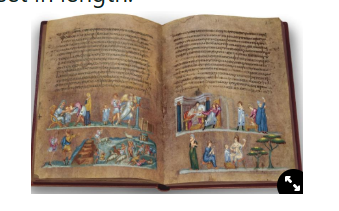
What are the three types of church architecture for Early Christianity, Romanesque and Gothic.
Barrel vault
Groin vault
Rib vault
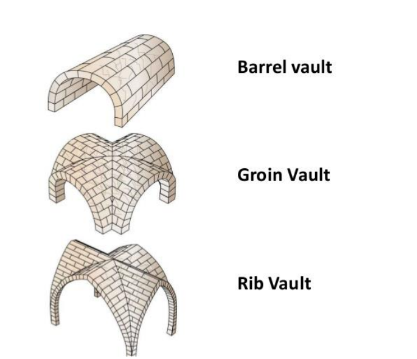
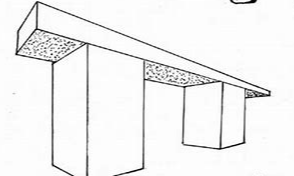
What is this an example of?
Post and lintel
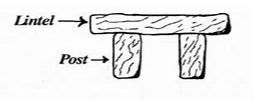
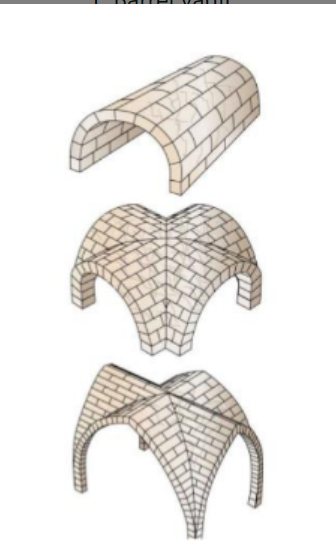
Name these
Barrel vault
Groin vault
Rib vault
What is a reliquary (a relic)
Why were important to the culture?
Imagery, meanings, story, use and relevance to the culture
Reliquaries: they contained relics of Christ, Mary, the Saints, or Holy Ones.
It was believed if prayed to healing, grace, or wishes would be granted.
Relics could be bone fragments, cloth, wood, etc
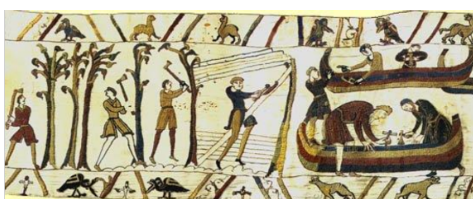
What is this?
What made it relevant?
Era (culture)?
Story?
Material?
Who created it?
The Bayeux Tapestry
Romanesque
Embroidered wool on linen
20” high x 230 ft long
Commissioned by Bishop Odo
Depicts the battle in Hastings between William the Conqueror and Harold the Saxon King.
Embroidered in continuous scenes, it would have most likely been sewn by several court women (leisure).
Note: Unlike a lot of Romanesque art, this work is secular in its subject matter. It’s depicting an actual historical event from the Norman perspective as opposed to a scene from Christianity
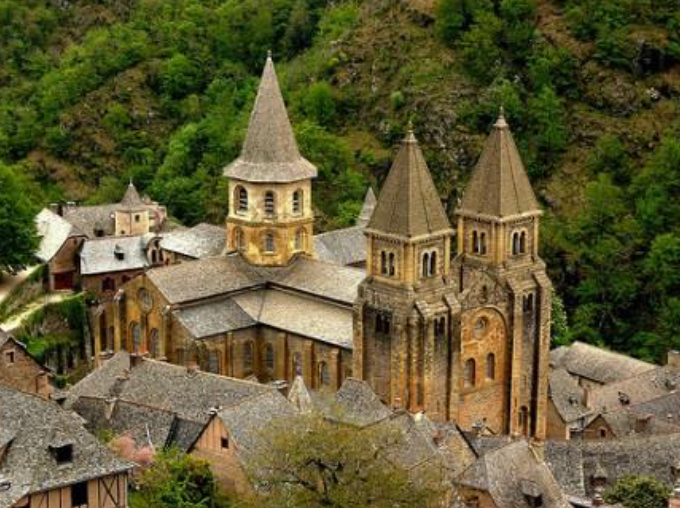
What is this?
Sainte-Foy at Conques: 1050-1120
A pilgrimage site
Sainte Foy is said to have been a child or young woman who was arrested by the Romans for her belief system (Christianity). She refused to worship the pagan gods- even under torture by a hot brazier. Thus, she received sainthood.
The church was built over top of her tomb in Conques, southern France.
The village of Conques was remote, but very popular with the pilgrims because of its relics.
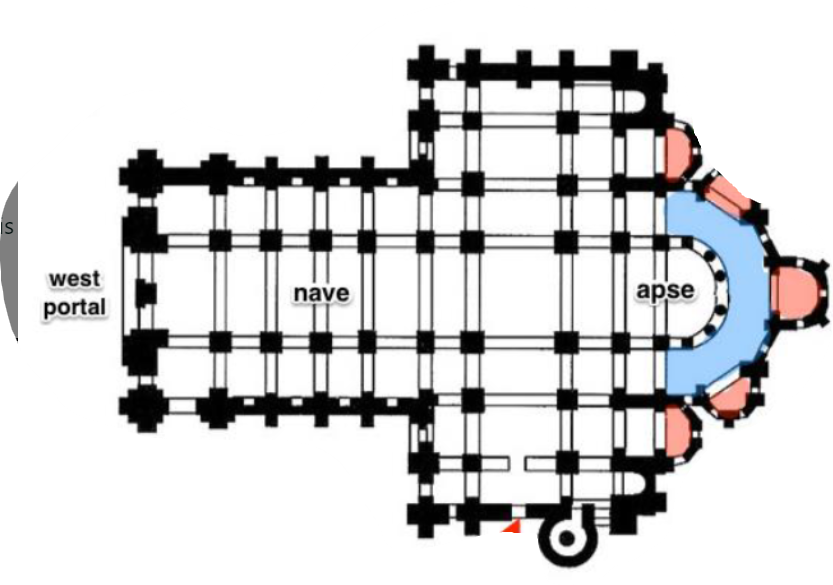
What floor plan is this? Why is the floor plan important
What’s different about this floor plan compared to Early
Christian churches?What is the style?
What was employed?
Sainte-Foy church
Romanesque refers to a style. This church architecture had round arches in the Roman tradition.
The church has the traditional Latin-cross basilica with some modifications: the side arms of the transept were extended around the apse forming an ambulatory.
This allowed the clergy to perform mass without the crowds of pilgrims interfering. They could remain in the main altar and access the choir.
There was also the addition of radiating chapels.
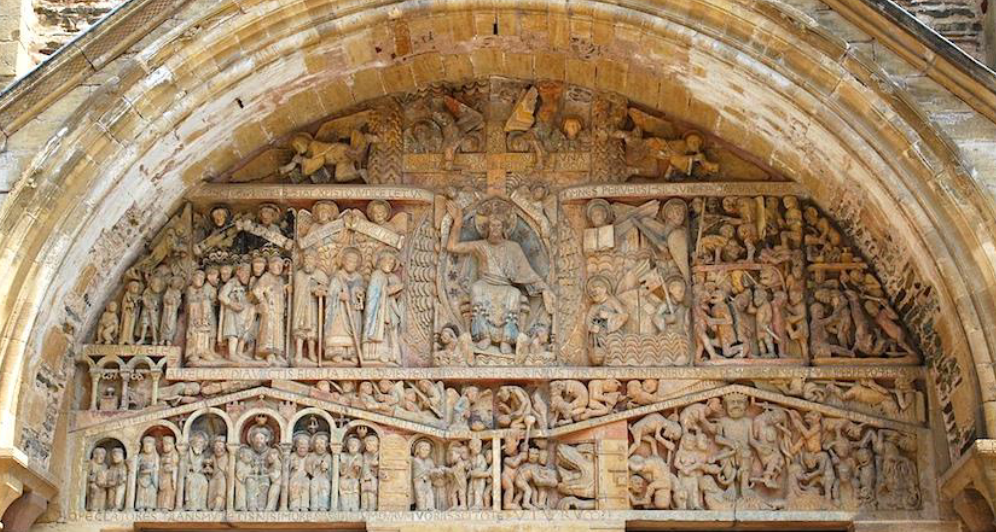
What is this? Details?
‘Last Judgement’: Sainte-Foy
Romanesque: 1050-1120 A.D.
Tympanum
It shows Christ seated as judge on whether souls will be received into heaven, or descend into hell.
His left hand points to hell, his rght to heaven: ‘the right hand of god’.
He’s surrounded by a mandoria, an oval of light and his halo contains the cross.
Note: the people in hell are a jumbled mess. The people in heaven are contained neatly in order. Christian dichotomy of good vs evil is present: the angels and the demons.

What is this? Where was it located?
Reliquary Statue of Sainte-Foy:
Located in Conques
Romanesque: 10th -11th century
33” high
Gold gilt over a wood core: gems and cameos added over the centuries
Relic for Sainte Foy: child martyr
Stolen from Agent, the town where she was from. It’s believed the head was cast from an existing death mask. Frontal position, large scale head compared to body. Her arms are open to receive the pilgrims into the church
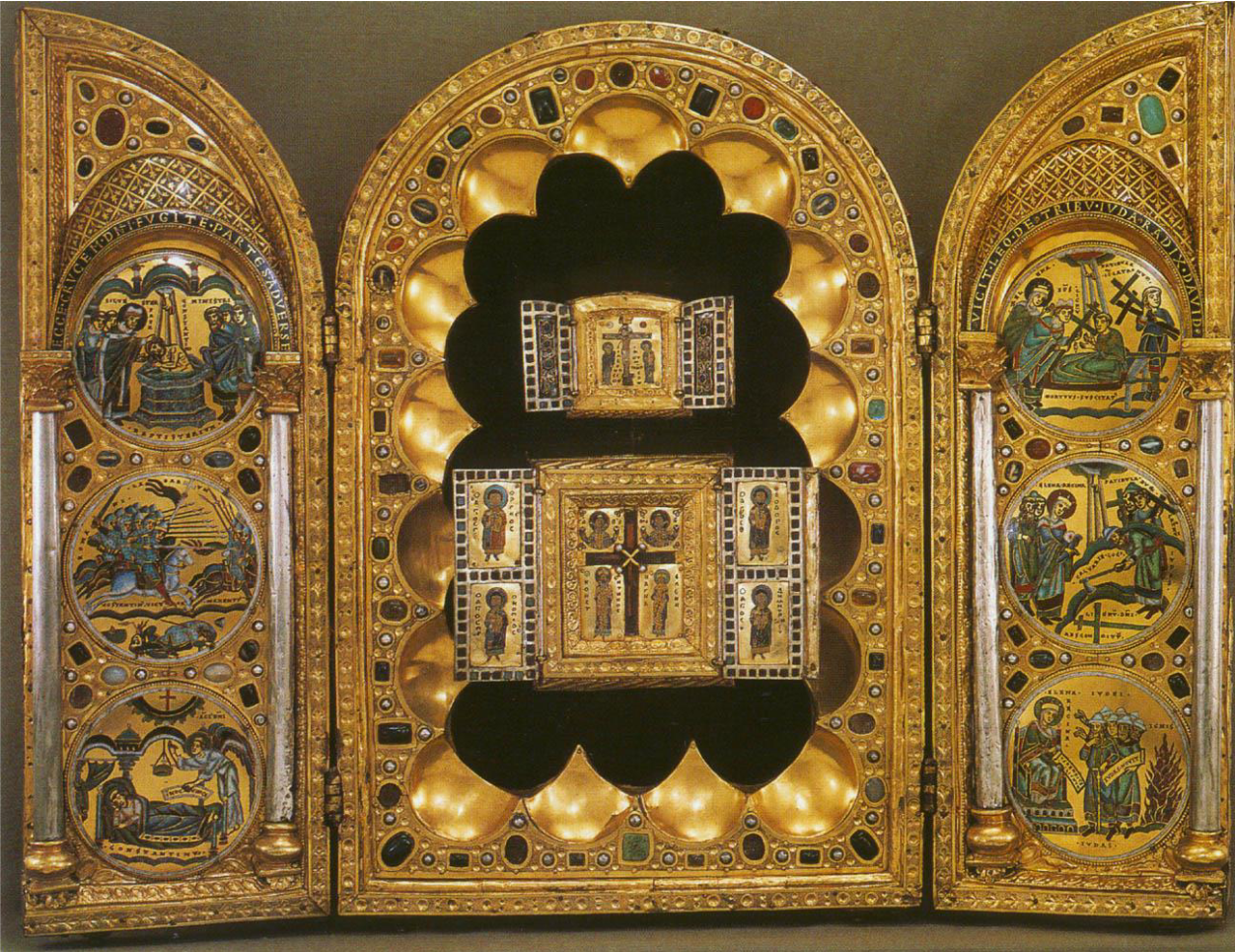
What is this?
What does it hold?
What are the two paneled stories telling?
What does circle mean in Christianity?
What style is this?
Stavelot Reliquary Triptych:
Contains the relics of the True Cross, Mary’s dress and a crucifixion nail.
‘Legend of the True Cross”
Romanesque
Gold, cloisonné enamel, inlay
19” high x 26” wide when open
Triptych: main Romanesque arch opening to two smaller triptychs framed with Corinthian columns. There’s a recess within the central cross that contains the relics of the True Cross, the Virgin’s dress, and the head of a nail used in the crucifixion.
Left panel: Emperor Constantine's conversion to Christianity- his visionary dream.
Right panel: Helena’s searching for the true cross in Jerusalem.
This is a pairing of eastern (Jerusalem) and western (Rome) Christianity. The circles symbolize the unending universality of Christianity. It reinforces the power of the Cross and its role in establishing Christianity as the official religion of Rome.
What are Elements of Gothic architecture?
1. Rib vaults
2. Piers
3. Flying buttresses
4. Pointed arches
5. The skeleton
6. Stained glass windows

What are these? Describe them
Rib Vaults
They replace the barrel vaults used in Romanesque architecture
This allowed for more space for windows (stained glass)
Weight of the building was more evenly distributed, ceiling vaults were reinforced and because the ribs bore the extra weight, lighter materials could be used for infilling between the ribs.

What are these (the columns)? Describe them
Piers
A weight bearing support system.
Large columnar supports on either side of the nave to which clusters of colonnettes are attached.
Also referred to as compound piers.
The ribs of the vault formed a series of lines that continued down onto the floor with the colonnettes then resting on compound piers.

What are these? Describe them
Flying Buttresses
An exterior structural support for the walls.
They’re thin half-arches or ‘flyers’ and support the wall where the thrust of the interior arch or vault is the greatest.
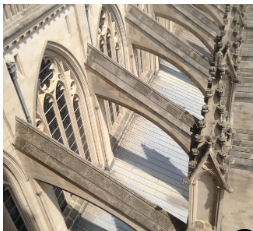
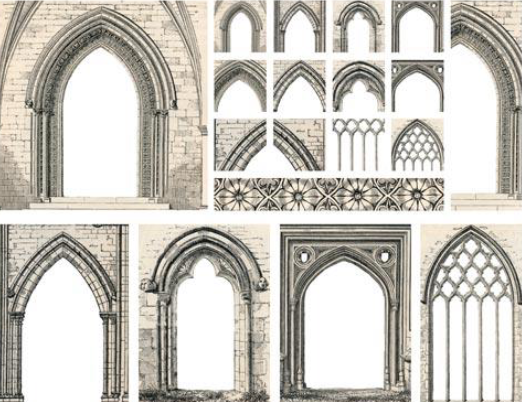
What are these? Describe them
Pointed Arches
Characteristics of Gothic Architecture.
Because the thrust of the arch’s height can be theoretically raised to any height, it allows for more building flexibility: higher arches and more extreme points are more dynamic and visually interesting than a Romanesque arch (gentle curve).
The spacing, width, and heights can vary and they’re used for multiple purposes (entries, stained glass).
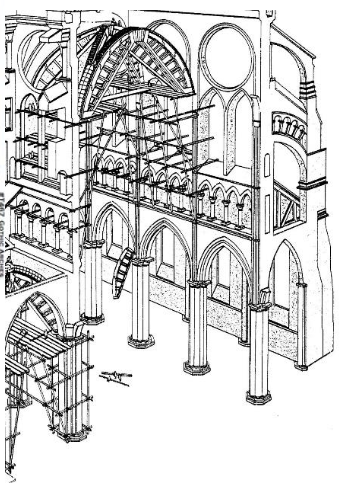
What is this? Describe it
The Skeleton
All of the previous characteristics of Gothic architecture are referred to as the ‘skeletal’ structure.
The main architectural supports: buttresses, piers and ribs, create a skeleton which non supporting elements like walls that can be attached.
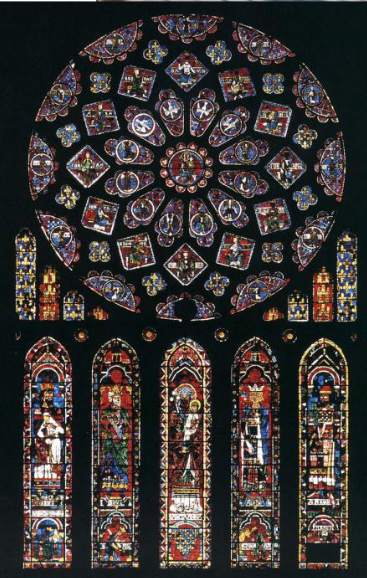
What is this? Describe it. What style is this?
Stained Glass Windows
Predominantly blue and red, pieces of coloured glass were cut into rough shapes which were then fit onto a model drawn on wood or paper (template).
Facial, drapery and plant details were added on top of the glass with black enamel.
The pieces were then baked in a kiln to harden the enamel. Once hardened, they were fused together with lead.
Rose windows were typical in Gothic churches and cathedrals.
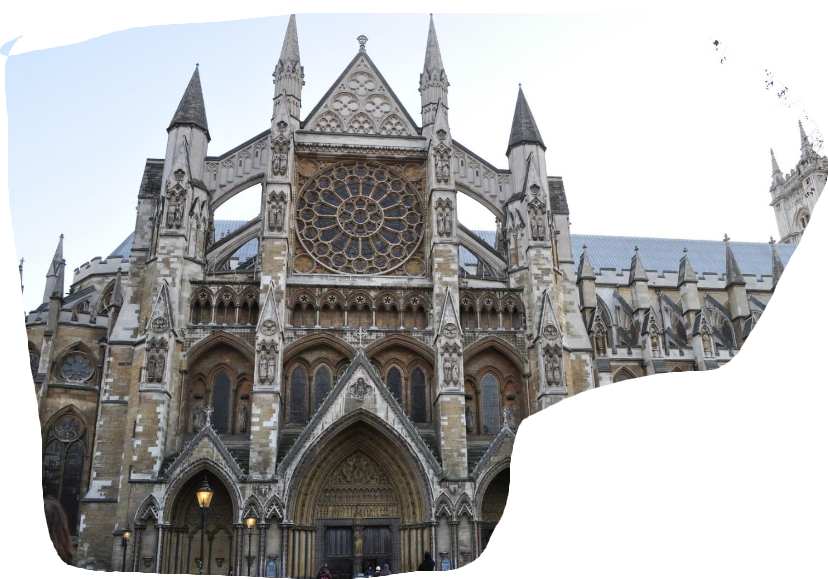
What is this showing and example of? And what style?
The Skeleton
• All of the previous
characteristics of Gothic
architecture are
referred to as the
‘skeletal’ structure.
• The main architectural
supports: buttresses,
piers and ribs, create a
skeleton which non-
supporting elements
like walls can be
attached.
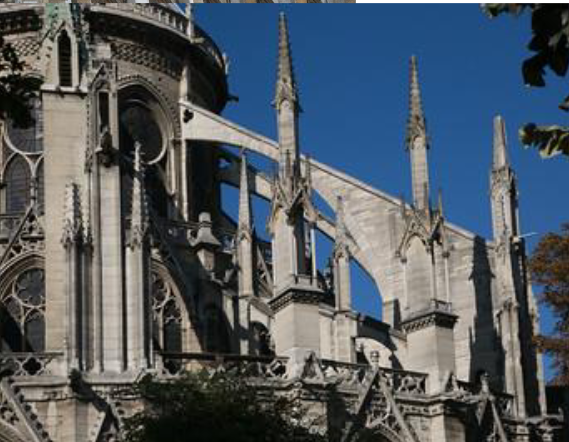
What is this an example of?
Flying Buttresses
• An exterior structural
support for the walls.
• They’re thin half-arches
or ‘flyers’ and support
the wall where the
thrust of the interior
arch or vault is the
greatest.
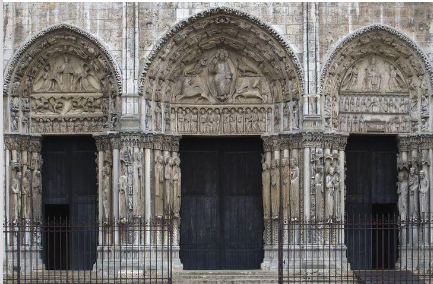
What is this? Style?
‘Last Judgement’: Sainte-Foy
Romanesque
Tympanum
It shows Christ seated as judge on whether souls will be received into heaven, or descend into hell.
His left hand points to hell, his right to heaven: ‘the right hand of god’.
He’s surrounded by a mandoria, an oval of light and his halo contains the cross.
Note: the people in hell are a jumbled mess. The people in heaven are contained neatly in order. Christian dichotomy of good vs evil is present: the angels and the demons.
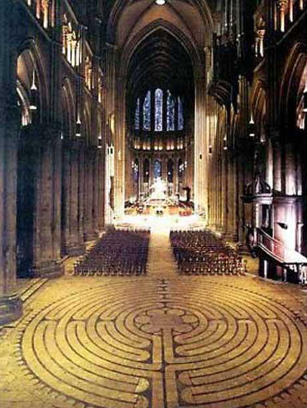
What is this? Style of architecture?
Pointed Arches
• Characteristic of Gothic
Architecture.
• Because the thrust of
the arch’s height can be
theoretically raised to
any height, it allows for
more building flexibility:
higher arches and more
extreme points are
more dynamic and
visually interesting than
a Romanesque arch
(gentle curve).
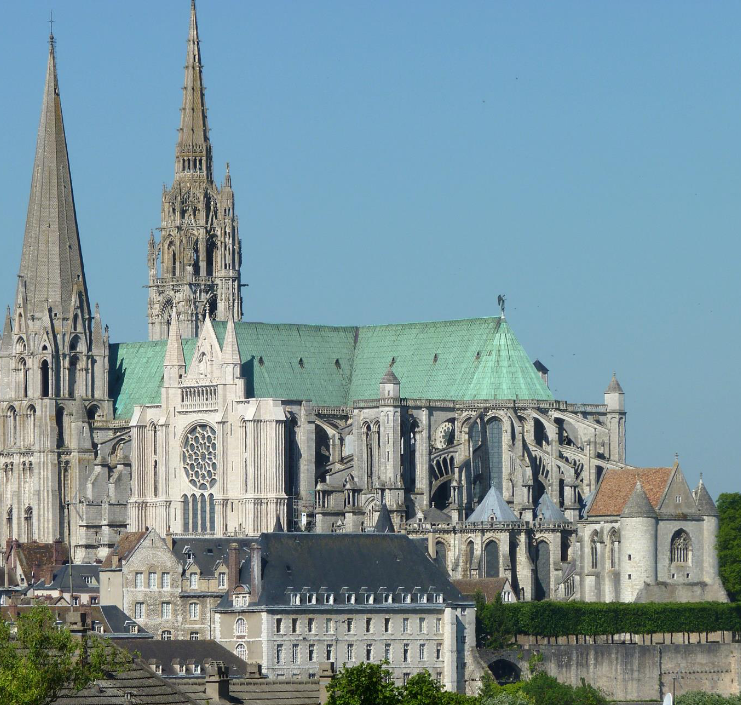
What is this an example of?
Gothic architecture
Chartres - city in France